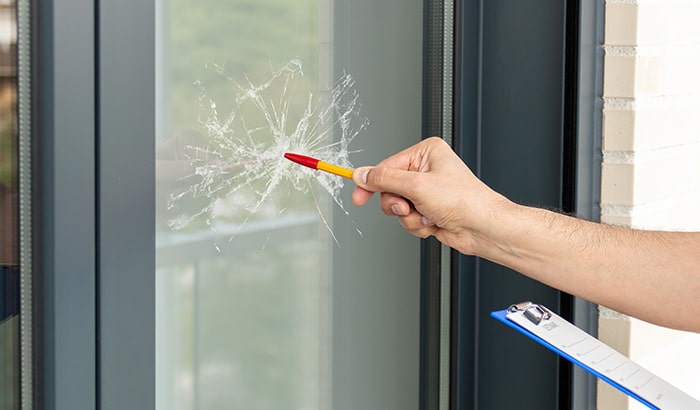We’ve all broken glass before. We cringe when we recognize the alarming sounds of glass cracking or shattering. And it is so easy to do. You set a glass down too hard, hit a baseball in the wrong direction of a window, or accidentally bump a vase off a shelf.
Hopefully, whatever is broken can be easily replaced. But what if the vase was your grandmother’s antique? Then, you might want to look into seeing if it can be repaired.
Repairing broken glass can be tricky. Depending on the type of glass or the damage, sometimes it is impossible to repair. Often, you have to weigh the importance of the glass, the cost of repair vs. replacement, and your technical and craft skills to determine whether or not a piece of glass can or should be repaired.
Thankfully, it is possible to repair broken glass under the right circumstances, and here is how.
What Kind of Glass Can be Repaired?
Not all broken glass can be repaired. If a window is double-paned and both panes are damaged, or if the single pane glass will be heated (such as a microwave or oven door), it is not recommended to repair the glass, but instead replace it with a new piece of glass.
Single-pane glass found in picture frames, mirrors, some glassware, and sidelites can usually be repaired as long as it did not break into multiple pieces and pieces are not missing. Chips and cracks in this type of glass can also be repaired effectively.
So if the type of glass can be repaired, how should someone repair it?
Melt it Back Together
Glass is made by mixing sand, sodium carbonate, calcium carbonate, and recycled glass. Then this mixture is heated in a specialized furnace. The average temperature of these furnaces is around 1400 degrees Celsius. That is over 2500 degrees Fahrenheit!
Once the glass mixture is heated, it can be poured onto a flat surface or shaped using a mold or specially designed tools to withstand the heat and manipulate the liquid glass. As it cools, the glass hardens and becomes transparent. For colors or levels of transparency, you can add different chemicals to the glass while it is hot to create other effects.
So if a glass object is damaged, you can just melt it and put it back together, right? Well, theoretically, that might work, but realistically, that solution is dangerous, expensive, time-consuming, and can cause more damage or unwanted changes to the piece of glass.
This is not to say that putting it back together this way is entirely impossible, but you will need a professional’s expert opinion and help.
If the repair is relatively simple, there are ways to repair glass using epoxy.
Epoxy Repair Process
If you attempt to repair broken glass, be aware that the fixes might still be reasonably noticeable. It’s always a good idea to repair cracks as quickly as possible to stop them from spreading and causing irreparable damage to the rest of the glass.
There are seven basic steps to repairing broken glass using epoxy.
1. Prep
Ensure you have all the equipment you need to repair the broken glass. This includes gloves, dish soap, glass cleaner, a wooden mixing stick, painter’s tape, a putty knife, a razor blade, and the correct epoxy for the project.
There are different brands of epoxy, so be sure to read the instructions for mixing ratios, curing time, and any other specific directions before you begin. Most epoxies must be combined in a disposable container before being applied to the glass surface.
Epoxy comes in 2 separate parts — a resin and a hardener. It’s important not to mix the two parts until just before you use them because once you mix them, the epoxy will quickly start to harden.
It is also essential to ensure your workspace is free of clutter, and the glass can remain undisturbed for 24 hours while the epoxy cures. More on that step later.
2. Clean
For the epoxy to stick effectively, the surface of the glass must be clean and free of dust and residue. Use a glass cleaner and then dish soap and warm water to clean the glass. Make sure you let the glass dry before moving on to the next step.
If possible, clean the edges of the broken pieces as well. This can be tricky, and you don’t want to cut yourself. So be very careful while handling the edges and cracks of the glass.
3. Mix epoxy
Most epoxy will come in a syringe-type applicator with separate cylinders for the resin and the hardener. When you apply pressure to cylinders evenly, you can usually get the correct ratio. But just to be safe, take a moment to read the directions carefully before opening the epoxy.
Stir the two materials together using a wooden stick until the materials are thoroughly mixed. Once the epoxy is mixed, you want to proceed quickly to the application.
4. Apply
The epoxy application will differ depending on the repair you are doing.
For cracks:
Use a putty knife to spread the epoxy over the entire crack, making sure to work it into the crack completely.
For fully separated pieces:
Use a putty knife or a wooden mixing stick to dab a small amount of epoxy on the edges of the broken pieces. Press and firmly hold the pieces together while applying painter’s tape to both parts to ensure they stay together.
In both applications, it is recommended to use epoxy sparingly. Start with a small amount and add more as needed. You will only have about 5 minutes to work with the epoxy before it starts to harden.
5. Remove excess
After about 5 minutes, you should have the broken glass filled with epoxy and starting to harden. As soon as you finish the application, you need to remove any remaining epoxy on the surface of the glass.
Use a razor blade at an angle to slice off the excess epoxy by sliding the blade away from your body. If you would instead not use a razor blade, you can use a rag with acetone to remove the excess epoxy.
This step is critical for the repair to look clear and smooth. If you leave extra epoxy on the surface, the fix will be very noticeable, especially if you are working on repairing a mirror. Removing the excess must be done quickly while the epoxy is still malleable.
6. Cure
The process of hardening is called curing and takes 12-24 hours. Even if the epoxy feels dry sooner than that, it has not fully cured to be as hard as it can be. Careful not to move the glass too much until the epoxy is completely cured.
7. Clean
Finally, give the glass another cleaning to remove fingerprints or tape residue. Of course, the
crack will still be visible at some angles, but this should prevent the damage from getting any bigger or more noticeable.
Voila! Your simple repair is finished. While we wish all broken glass could be fixed using these steps, there are just some circumstances in which you must replace the glass, and even the best DIYer should get help from professionals for any glass installation.
Repair or replace glass in your home with Murray Glass
Our experienced professionals will provide a thorough consultation and exceptional service and craftsmanship. As Utah’s glass experts, Murray Glass is available around the clock throughout Utah, Salt Lake, Summit, Weber, and Tooele counties.
If you need a repair or wish to upgrade the glass in your home or business, contact Murray Glass for a free estimate today!





